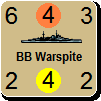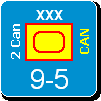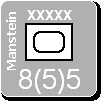warspite1
Posts: 41353
Joined: 2/2/2008
From: England
Status: offline

|
The Kiwis have three surface ships in WIF and I intend to post one example (although may do a second if I am a little unsure of some of the facts. Here is the first, which includes stories from the British Pacific Fleet operations in 1945. I would be interested to know how she was crewed when transferred to the Kiwis i.e. did she have an English crew that changed when she visited New Zealand in early 1945 (unlikely I would have thought), or had the crew of Leander and /or Achilles previously sailed for the UK?? (Help please anyone?):
[4012 Gambia - by Robert Jenkins]
.B Engine(s) output: 72,500 hp
.B Top Speed: 31.5 knots
.B Main armament: 12 x 6-inch (152mm), 8 x 4-inch (102mm) guns
.B Displacement (full load): 10,450 tons
.B Thickest armour: 3.5-inch (belt)
.P The Colony-class consisted of eleven light cruisers built for the Royal
Navy (RN) during the Second World War. They were built in two groups; Fiji and
Ceylon, with the latter ships being built to a slightly revised design.
.P All but two ships were were actually laid down before the outbreak of World
War II and were designed within the confines of the Second London Naval Treaty.
This lowered the 10,000 ton cruiser limit set in 1922 to 8,000 tons. The class
were in many respects smaller versions of the last two Town-class cruisers,
being 35 feet shorter and with a slightly thinner 3.5-inch belt armour. The
supply system for the anti-aircraft (AA) weaponry was improved over that in the
last two Town-class ships.
.P The three ships that made up the Ceylon group were built with no X-turret and
this allowed additional AA weaponry. Most surviving members of the Fiji group
had their X-turrets removed in the latter stages of the war. Aircraft facilities
were also removed from all ships. Note, Fiji and Kenya were not fitted with
aircraft capability at completion.
.P Visually, the Colonies differed from the Town-class as they featured straight
funnels and masts as opposed to the raked design of the earlier ships. They
proved to be an excellent design that served the RN well in all the main theatres
of the Second World War.
.P HMS Gambia was completed in February 1942. World In Flames depicts this ship
as a unit of the Royal New Zealand Navy (RNZN), although she began life in the
RN before being lent to the RNZN in 1943 (see below).
.P Gambia was earmarked for deployment with the 4th Cruiser Squadron (CS),
Eastern Fleet and after working-up with the Home Fleet, she sailed to her new
station in April, escorting a military convoy as far as South Africa on her way
to Kilindini, East Africa. Kilindini was the port to which the Eastern Fleet had
had withdrawn in April, following Admiral Nagumo`s Indian Ocean raid (see HMS
Cornwall). Now, with the Japanese having been checked by the US Navy at the
Battle of the Coral Sea, the RN were looking to re-establish their forward base
at Trincomalee, Ceylon. Gambia sailed with the battleship Warspite and the
carriers Illustrious and Formidable for Ceylon in May.
.P However, the Eastern Fleet was in no position at that time to undertake
offensive operations against the Japanese, and Gambia was deployed on convoy
escort and patrol duty in the Indian Ocean until August, when she was ordered to
return to East Africa to prepare for Operation Stream. Stream was the code-name
for the landings at Majunga, on the Indian Ocean island of Madagascar, planned
for that September and was designed to complete the occupation of the island that
was originally invaded in May (see Amphibious Counter 4712).
.P For Stream, Gambia was deployed in Force M alongside Warspite, Illustrious
and the cruisers Birmingham, Caradoc and Dauntless. For the actual assault,
Gambia escorted the transports taking the 29th Infantry Brigade to Majunga along
with the cruisers Birmingham and the Dutch cruiser Heemskerck. Although progress
was slow for the Allied forces, they eventually took the capital, Tananarive, and
the fighting ended on the 18th October. Gambia remained in the area to assist
operations until October, when she returned to Bombay, India and convoy defence
duty in the Indian Ocean once more. This deployment continued until March 1943
and included the escort of the Pamphlet convoy that took Australian troops back
home from the Middle East (see Transport Counter Queen Elizabeth and Queen Mary).
.P In March, Gambia was briefly named as Flagship of the 4th CS and took part in
fleet exercises in the Indian Ocean as the RN prepared to go back onto the
offensive in that region. She sailed to the UK in June and underwent a refit,
during which she had her aircraft facilities removed. She was at this time lent
to the RNZN to replace the damaged cruisers, Achilles and Leander. Her actual
commissioning took place in September. After work-up with the Home Fleet, she was
transferred to Plymouth on the English Channel coast for service in the South
West Approaches. There, Gambia was deployed with the cruisers Glasgow and
Enterprise off the Azores for interception of supply ships and blockade runners;
Operation Stonewall (see HMS Enterprise).
.P In January, Gambia was prepared for service with the Eastern Fleet once more,
and she sailed for Ceylon at the end of that month to join the 4th CS. Upon
arrival in Ceylon, she was deployed on convoy escort and patrol duty and then in
March, she took part in the large-scale fleet exercise, Operation Diplomat (see
HMS Queen Elizabeth).
.P The following month, Gambia was part of the newly reinforced fleet that was
now able to mount its first offensive strike against the Japanese; Operation
Cockpit, against Sabang on the island of Sumatra. This was followed by Operation
Transom against Soerbaya, Java the following month (see HMS Nigeria). In June,
Gambia took part in Operation Councillor, a carrier strike operation launched
from Illustrious against Padang, also on Sumatra (see HMS Ceylon).
.P In July, the Eastern Fleet, having been reinforced earlier that month by the
carriers Victorious and Indomitable, launched Operation Crimson. This was another
carrier strike against Sabang. It was also the last operation for Admiral James
Somerville, who had led the Eastern Fleet since the dark days of early 1942. For
Crimson, the fleet consisted of the carriers Illustrious and Victorious; the
battleships Valiant and the Free-French Richelieu; the battlecruiser Renown; the
cruisers Ceylon, Cumberland, Gambia, Kenya, Nigeria, Phoebe and the Dutch cruiser
Tromp; and ten destroyers. Fleet Air Arm (FAA) Corsairs attacked Japanese
airfields and surrounding targets, while the rest of the fleet took part in
bombardment of enemy positions in and around the harbour. During the mission, the
fleet came under attack from Japanese aircraft, and two British fighters were
shot down. However, none of the attackers penetrated the AA screen and suffered
heavy losses themselves in the process. The only other damage was to Tromp and
two destroyers, which were hit by enemy shore batteries. Following this
operation, Gambia was to receive a refit to prepare for her next deployment; the
Pacific.
.P Gambia joined the British Pacific Fleet (BPF) upon its formation in November
1944, although at the time she was in Australian waters. She then sailed for
Auckland, New Zealand and her first visit to her adopted home country, where she
received her refit ahead of her physically joining the BPF. The BPF had by
February reached Australia to begin preparations for service in the Pacific.
However, even after their arrival in Australia, it was by no means certain what,
if any, future role the BPF would play.
.P Ultimately, it was agreed that they would operate as Task Force 57 (TF57), as
part of the US 5th Fleet and at the end of March, they were tasked with assisting
5th Fleet during the invasion of Okinawa. The BPF were given a subsidiary
operation, Iceberg One, against Japanese airfields and installations on the
Sakishima-Gunto island chain, west of Okinawa (see HMS Swiftsure). After a period
of replenishment, TF57 returned for a repeat operation, Iceberg Two, in May (see
HMS Howe). During both of these operations, the fleet was subjected to Kamikaze
strikes, but Okinawa was secured; the American forces, with their Allied support,
were now at the gates of the Japanese home islands.
.P In June, the BPF sailed for replenishment once more and to prepare for the
final strikes against mainland Japan in July and August. The BPF were now named
Task Force 37 (TF37), operating as part of the US 3rd Fleet. Gambia took part in
these operations (see HMS Black Prince, HMS Formidable and HMS Newfoundland).
.P On the 11th August, TF37 was reduced in size due to problems with getting
sufficient fuel supplies to the fleet, although Admiral Nimitz had in any case,
only agreed to allow a token British force to remain off Japan as part of the
occupation force. Task Group 38.5 (TG38.5), as this small unit was known,
consisted of the carrier Indefatigable, the battleship King George V, the
cruisers Newfoundland and Gambia and nine destroyers. With the Japanese surrender
still not confirmed, strikes against Japan continued and on the 13th August,
TF37`s FAA squadrons attacked airfields and shipping in northern Honshu and
Hokkaido. The final strikes were made the next day, during which a Seafire pilot,
Sub-Lt Hockley, was hit by flak while east of Tokyo. He was able to bail out, but
was then captured and executed that same afternoon.
.P After operations ceased, Gambia arrived in Tokyo Bay with TG38.5 at the end of
August and was present when the Japanese formally surrendered to the Allies on
2nd September 1945 (see HMS Duke of York).
.P Back with the RN after the war finished, HMS Gambia was scrapped in 1968.
< Message edited by warspite1 -- 10/5/2009 1:21:20 PM >
_____________________________
England expects that every man will do his duty. Horatio Nelson October 1805  |
 Printable Version
Printable Version








 ).
). 


 .
. 

 New Messages
New Messages No New Messages
No New Messages Hot Topic w/ New Messages
Hot Topic w/ New Messages Hot Topic w/o New Messages
Hot Topic w/o New Messages Locked w/ New Messages
Locked w/ New Messages Locked w/o New Messages
Locked w/o New Messages Post New Thread
Post New Thread